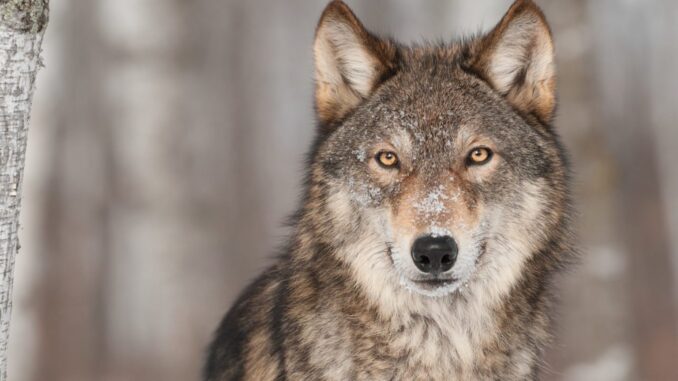
In November 2020, Colorado voters approved Proposition 114, which mandated Colorado Parks and Wildlife develop a plan to start reintroducing gray wolves (Canis Lupus) to the western part of the state by 2023. The initiative passed narrowly with 50.9 percent of the Colorado public voting in favor.
Given the close nature of the vote and the need to integrate diverse perspectives in the wolf reintroduction plan, researchers at the Colorado State University Center for Human-Carnivore Coexistence conducted two studies on what influenced public voting on the issue.
Wolves were eliminated from Colorado by the 1940s through a government-sponsored eradication campaign. Wolf reintroduction is a contentious issue, affecting diverse stakeholders, including ranchers, hunters, and environmental and animal advocates.
Survey Finds Change in Public Perception on Wolves
The first study, called “Rapid changes in public perception toward a conservation initiative” and published in the journal Conservation Science and Practice, was led by Rebecca Niemiec, assistant professor in the Human Dimensions of Natural Resources department in the CSU Warner College of Natural Resources.
The study examined why the 2020 vote was so close despite surveys over the last 25 years finding high levels of support for wolf reintroduction.
Niemiec examined this discrepancy via a post-election survey of Colorado residents. Findings include that online survey methods overestimated public support for wolf restoration in Colorado, as well as evidence that public perception about wolf reintroduction had changed. This change may have been the result of outreach campaigns by groups opposed to wolf reintroduction and by media coverage portraying more negative than positive arguments about reintroduction.
Additionally, when survey respondents were asked why they voted for or against the reintroduction of wolves, a common response was the ability to restore ecological balance, improve the environment, and the belief that protecting wolves was the right thing to do.
Common arguments against wolf reintroduction were the impacts of wolves on livestock, agriculture, and ranchers. Also, there was a belief that reintroduction was unnecessary given wolves were already in the state, as a small group of wolves, likely originating from Wyoming, were detected in northwestern Colorado in the year prior to the election.
The results highlight the dynamic nature of public opinion on this complex and controversial conservation issue, but also the need for additional survey methods to better understand public opinion, Niemiec said. “Moving forward, it will be critical to monitor how public perception changes over time to better integrate diverse perspectives to help reduce conflict over wolves in Colorado.”
Study Evaluates Drivers of Vote for or Against Wolf Reintroduction
A second study led by Mark Ditmer, a postdoctoral researcher at the Center for Human-Carnivore Coexistence, evaluated the social and ecological drivers of the voting patterns of the over 3 million Coloradans who voted for or against wolf restoration via Proposition 114.
The study, titled “Socio-ecological drivers of public conservation voting: Restoring gray wolves to Colorado, USA” published in the journal Ecological Applications, analyzed precinct-level voting data from the Colorado Secretary of State. The study found that voter support for Proposition 114 had a strong positive relationship with voter support for President Joe Biden.
Additionally, the study found that younger and more urban voters had greater support for the initiative, whereas areas with more elk hunters had less support. In addition, precincts closest to locations where wolves had been recently detected, and also more broadly in the Western Slope region – where the state’s wolf reintroduction process will be targeted – tended to have less support for reintroduction relative to the rest of the state.
“Our study highlights the very close correlation between how people voted for president in the 2020 election and whether they chose to support wolf restoration in Colorado,” said Ditmer, who is now an ecologist at the U.S. Forest Service-Rocky Mountain Research Center.
“The politicization of wolf restoration reflects a broader trend of politicization of science. Such polarization poses a challenge to conservation efforts to protect our natural world.”
Insights Help Reduce Conflict About Wolf Reintroduction
These studies demonstrate that understanding factors influencing public perceptions toward conservation initiatives and engaging diverse stakeholders with a variety of opinions are both critically important for developing successful conservation policies and management actions, said Kevin Crooks, director of the Center for Human-Carnivore Coexistence.
“These findings are important for highly politicized issues such as wolf reintroduction,” Crooks said. “Reintroduction will require outreach and engagement strategies to reduce polarization.”
“Through understanding public perception, and integrating diverse voices, we can find real-world solutions to reduce conflict and facilitate coexistence between people and wolves.”
A study to further understand the social outcomes of CPW’s public and stakeholder engagement process for wolf reintroduction planning is currently being conducted by Niemiec and her colleagues in collaboration with Colorado Parks and Wildlife.
Support Northern Colorado Journalism
Show your support for North Forty News by helping us produce more content. It's a kind and simple gesture that will help us continue to bring more content to you.
BONUS - Donors get a link in their receipt to sign up for our once-per-week instant text messaging alert. Get your e-copy of North Forty News the moment it is released!
Click to Donate
